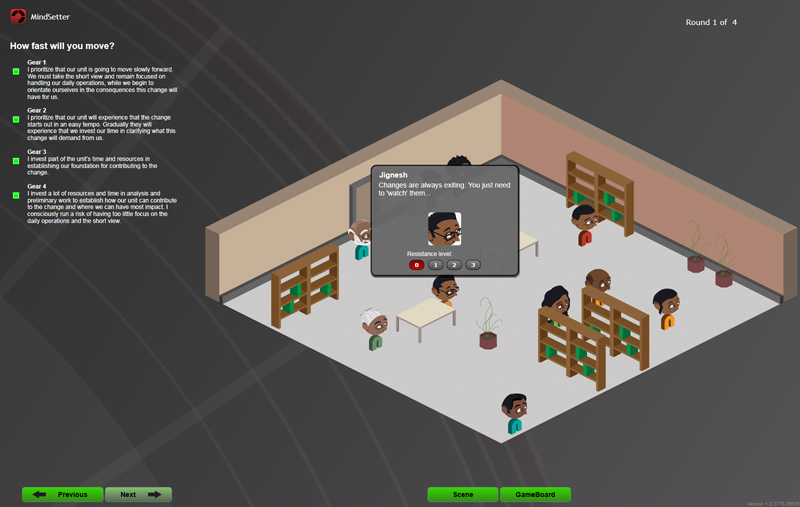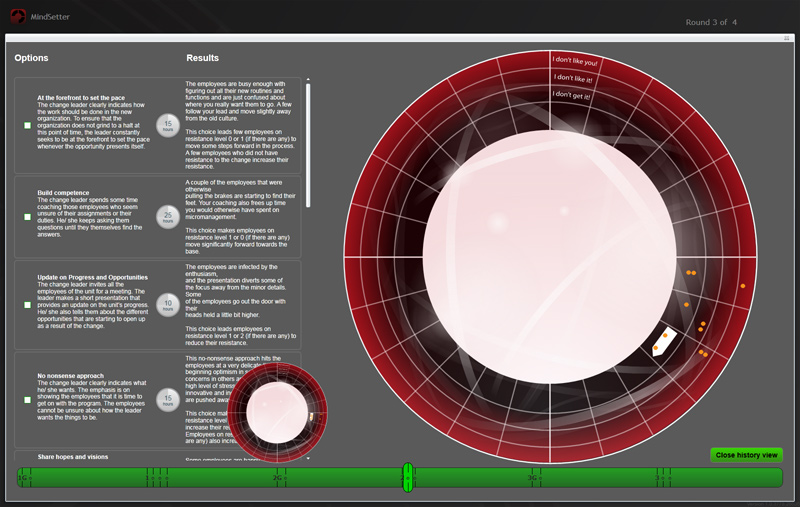Mindsetter
MEDEA Highly Commended 2010

Mindsetter is a learning game on change management, created in 2009 by Christian Harpelund and currently used at the Danish School of Education (Denmark). It is meant to teach employees, consultants and managers how to recognize and work with resistance to change in their organisation or project. The game, available in Danish or English, is based on a model provided by Rick Maurer, called 3 levels of resistance, and aims to make this model come alive to the participants.
At the start of the game, the participants are provided with a challenge, e.g. to change the current values of an organisation. They have to go through 4 phases: initial recognition of the need to change, planning, implementing and integrating. In the game, the participants (or players) manage a department with 10 employees who are opposing the change and, dependent on what the players decide to do, these employees will leave the project by resisting the change in different manners.
The goal of the game is to navigate the project (illustrated as a boat in the game) through all 4 project phases while keeping the employees on board, as well as trying to pick those up who leave the project. The game can be played as a board-game with up to 40 participants, or it can be played as a simulation, either as a group or in solitary. The game-interface provides an interchangeable case, which can be played in both ways. The purpose of the game is to make the theory come alive to the participants; rather than remembering that decision A leads to employees leaving the project while exhibiting resistance condition B, the participants are allowed to experiment with different kinds of change management behaviour while experimenting with and experiencing their consequences. While the board-game explains the theory to the participants, the simulator helps speed up the participants' experiments, thereby allowing them to emphasise the experimental element of the learning process.
The game is currently being used with top- and middle managers, at university programmes teaching adult education, human resource management, change management and game-didactic design. It is first used for teaching the particular theory (Rick Maurer's 3 levels of resistance) and is used afterwards to design and test change scenarios for particular change projects.
What the judges said about Mindsetter:
The judges feel that the use of a multiplayer game will make it very stimulating and interesting for players/users, particularly students playing in teams. While it is still a complex game, the content is clever, rich and relevant and meaningful, and the addition of live video would also be very useful to illustrate some aspects in the game.
The pedagogical approach is a good mix of problem based learning and case study simulation: the game provides an effective way to see the simulated results that certain decisions have on employees and besides putting the theory into practice, it can also be used as a tool to see what went wrong in past decisions. This means that the learning process does not stop once the theory is taught.
About the creation of Mindsetter
Dr Thomas Duus Henriksen, Assistant Professor in Learning Games at the Danish School of Education, says: “The game was originally created as a board game to be played for 4-8 hours and facilitated by a consultant. This provided a good understanding of the game. To allow for active experimentation, an online simulator was created to speed up subsequent playing time and allow the participants to replay the scenario. The online version facilitated distribution as well as providing the participant an opportunity to replay the game, e.g. just before a change project was due.
When used at a university, a class (30 participants) play the game in four groups. Each group controls a different department, but they are all implementing the same change project. The game is facilitated by a teacher, who also presents the theory necessary. After having completed all 4 phases, the participants are given access to the simulation. This is played after class, and at the following session, the theory is reflected and discussed in regard to a current change project. This especially proves to be effective in management classes where participants are required to plan an upcoming change project as feedback from learners and teachers indicate that the participants gain an understanding of change management and resistance to a degree that allows them to plan change projects more effectively, as well as to understand why past and current change projects seem to be failing.”



